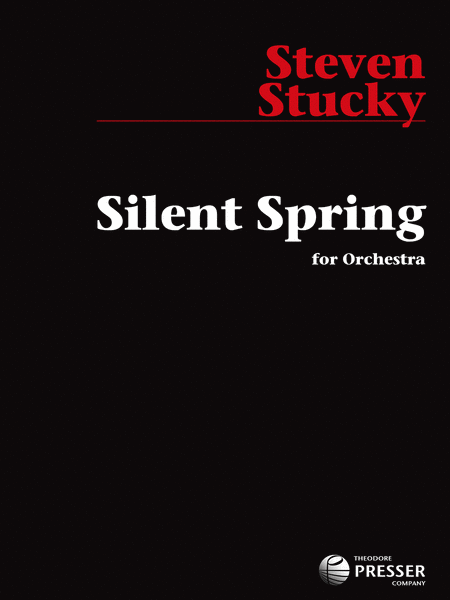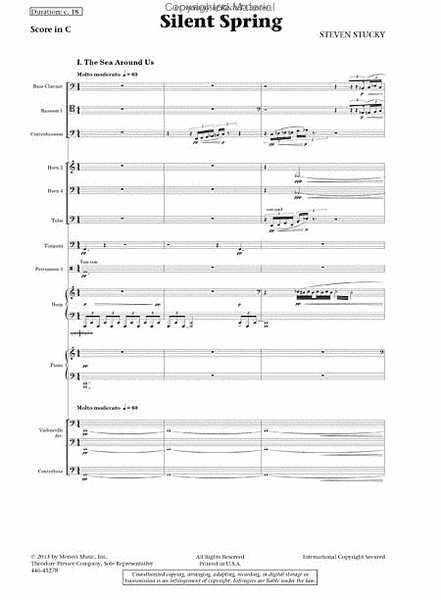Silent Spring
For Orchestra
-
Ships in 1 to 2 weeks
Details
Description
SKU: PR.446412780
For Orchestra. Composed by Steven Stucky. Sws. Contemporary. Full score. With Standard notation. Composed 2011. 76 pages. Duration 18 minutes. Theodore Presser Company #446-41278. Published by Theodore Presser Company (PR.446412780).ISBN 9781598064810. UPC: 680160606542. 9x12 inches.
Commissioned by the Pittsburgh Symphony Orchestra, Manfred Honeck, Music Director, in commemoration of the 50th anniversary of the publication of Rachel Carson’s Silent Spring. Because the book is "almost all science," Stucky says, he instead chose four books by Carson (including Silent Spring) as the base for his contemplative composition. "The entire work seized the thrust of Carson’s mid-century warning about chemical pollutants, but was arresting in a more general way for me. Mr. Stucky’s appropriate pessimism here didn’t discourage as much as it engendered a cathartic response to a subject that often numbs the soul. A brilliant, if unsettling, work." (Andrew Druckenbrod, Pittsburgh Post-Gazette) Duration: c.18'.
Fifty years ago, when Rachel Carson’s Silent Spring was published in 1962, I was twelve. Even though the book was an overnight sensation, at that age I wouldn’t have noticed it for a year or two. But by fourteen or so, I was immersed in the intersections between science and public policy. I rememberdoing a big school project about smoking and lung cancer, for example, then scandalous breaking news — like the devastating effect of DDT and other pesticides on the world around us that Carson revealed in Silent Spring. And by then, I had read and been deeply influenced by her masterwork. Thus, like a whole generation, my world view was significantly shaped by her.Fifty years later, it is time to celebrate Rachel Carson’s signal contributions. I was delighted when the Pittsburgh Symphony, in collaboration with the Rachel Carson Institute at her alma mater, ChathamCollege, suggested that I write a new piece reflecting on the anniversary. But I was perplexed, too. I reread Silent Spring and Carson’s other work, of course, and I reveled again in the distinctive mixture ofhard science and eloquent lyricism that defines her voice. Yet Silent Spring is almost all science. How to make music about that?Instead, I gathered together four of Carson’s titles: The Sea Around Us (Carson’s 1951 bestseller about oceanography); The Lost Woods (the title of a Carson letter published in Lost Woods: The Discovered Writings of Rachel Carson); Rivers of Death (a chapter title in Silent Spring); and the title Silent Spring itself. With these titles as cues, I could fashion a one-movement orchestral tone poem in four sections that tries to create an emotional journey from beginning to end without referring specifically to thescientific details.The result is music at once “abstract” and “programmatic” (already two categorical and hence undependable labels). The Sea Around Us is murky water music: it rises from the depths of the orchestra until it reaches a grand but melancholy chorale evoking the vast expanses of the sea. The Lost Woodcalls forth a desolate chaconne (i.e., a set of variations over a cyclic chord progression). The sombre atmosphere grows more and more intense until it leads to a short, scathing scherzo, Rivers of Death. The diabolical “death scherzo” music, too, escalates until it cannot go any further, instead bursting into the ecstatic mass singing of Silent Spring. But — like the insects and birds that Rachel Carson wrote about — one by one those ecstatic orchestral voices fall silent. We are left with near-silence. Rachel Carson’s trenchant writing gave us data, marching orders, the heart to do what is right; but, likeall great writing, it also gave us the spiritual and psychological space to contemplate our own thoughts about the world around us, about our own place in that world, about our own hopes and fears. Music cannot — should not attempt to — explain, preach, proselytize, comment on real life. Its domain is emotional life, not “real” life. It is non-specific, non-semantic, non-representational. My Silent Spring isthe same: a space in which to contemplate one’s own fears, hopes, and dreams.


 Share
Share